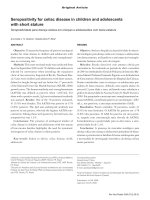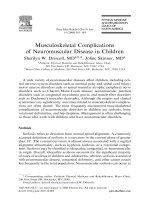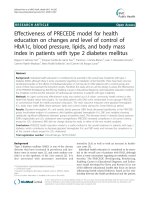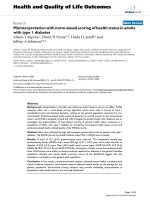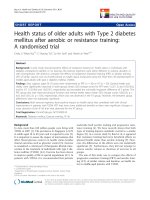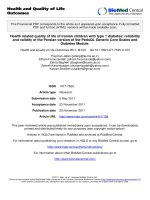Prevalence of Celiac disease in Turkish children with type 1 Diabetes Mellitus and their non-diabetic first-degree relatives pptx
Bạn đang xem bản rút gọn của tài liệu. Xem và tải ngay bản đầy đủ của tài liệu tại đây (72.01 KB, 5 trang )
INTRODUCTION
Type 1 Diabetes Mellitus (T1DM) is a common au-
toimmune disease in children. The risk for other
autoimmune disorders is increased in children
with T1DM and their relatives (1). Recent data ha-
ve supported that Celiac disease (CD) is an auto-
immune disease triggered by the ingestion of glu-
ten in genetically susceptible individuals (2).
Strong evidence for the association between T1DM
and CD has been shown in children. Up to 8% of
patients with T1DM have the characteristic featu-
Turk J Gastroenterol 2010; 21 (1): 34-38
Manuscript received: 08.11.2008 Accepted: 05.11.2009
doi: 10.4318/tjg.2010.0045
Address for correspondence: Ediz YELKAYA
Gỹlhane Askeri Tp Akademisi
ầocuk KliniÔi Etlik, Ankara, Turkey
E-mail:
Prevalence of Celiac disease in Turkish children with
type 1 Diabetes Mellitus and their non-diabetic
first-degree relatives
Tip 1 Diyabetli Tỹrk ỗocuklarnda ve onlarn birinci derecede yaknlarnda ầửlyak
hastalÔ sklÔ
Sinan SARI
1
, Ediz YELKAYA
2
, ệdỹl ERTA
1
, Aysun BDEC
2
, Peyami CNAZ
2
, Buket DALGIầ
1
Departments of
1
Pediatric Gastroenterology and
2
Pediatric Endocrinology, Gazi University, School of Medicine, Ankara
Amaỗ: Bu ỗalmada tip 1 diyabetli Tỹrk ỗocuklarnda ve on-
larn diyabetik olmayan birinci derece yaknlarnda ầửlyak
hastalÔ sklÔnn aratrlmas amaỗlanmtr. Yửntem: Tip
I diabetes mellitus tanl 48 ỗocuk (K/E=30/18, ya aralÔ 3,5-
23 yl, ya ortalamas 12.09 4.78 yl), diyabetik olmayan 29
karde, 40 ebeveyn ve 103 saÔlkl ỗocuk anti-doku transgluta-
minaz, IgA, IgG ve serum total IgA dỹzeyleri baklarak ầửlyak
hastalÔ iỗin tarand. Antikor pozitifliÔi saptanan olgulara in-
ce barsak biyopsisi yaplmas teklif edildi. Bulgular: 48 diya-
betli ỗocuÔun 8inde anti-doku transglutaminaz IgA pozitifliÔi
saptand. ki diyabetli ỗocukta selektif IgA eksikliÔi saptand ve
her ikisinde de anti-doku transglutaminaz IgG pozitifti. ntes-
tinal biyopsi, ầửlyak serolojisi pozitif 10 hastann 8i (%80) ta-
rafndan kabul edildi. ĩỗ diyabetik ỗocukta (%6,3) total villửz
atrofi tespit edildi. Bir karde ve ebeveynlerin ikisinde anti-do-
ku transglutaminaz-IgA pozitif bulundu. Kardete biyopsi ile
ầửlyak hastalÔ doÔruland. Ebeveynler intestinal biyopsiyi
kabul etmedi. Diyabetik ỗocuklarn akrabalarnda biyopsi ile
kantlanm ầửlyak hastalÔ sklÔ %1,4 olarak bulundu.
Kontrol grubunda hiỗbir ỗocukta anti-doku transglutaminaz
pozitifliÔi tespit edilmedi. Sonuỗ: Diyabetli ỗocuklarda ầửlyak
hastalÔ sklÔnn saÔlkl ỗocuklara gửre yỹksek oranda oldu-
Ôu gửrỹldỹ. Diyabetik ỗocuklarn akrabalarnda biyopsi ile ka-
ntlanm ầửlyak hastalÔ sklÔnda kontrol grubuna gửre
fark bulunmad.
Anahtar kelimeler: Tip I diyabet, ầửlyak hastalÔ, ỗocuk, akra-
balar
Background/aims: The objective of this study was to determi-
ne the prevalence of Celiac disease in Turkish children with
type 1 Diabetes Mellitus and their non-diabetic first-degree re-
latives. Methods: Forty-eight children with type 1 Diabetes
Mellitus (18 males, 30 females; age range: 3.5 to 23 years; mean
age: 12.09 4.78 years), 29 non-diabetic siblings, 40 non-diabe-
tic parents, and 103 healthy children were screened for celiac
disease using the IgA and IgG anti-tissue transglutaminase an-
tibody and total serum IgA. Small intestinal biopsy was offered
to all antibody-positive patients. Results: Eight of 48 diabetic
patients had positive anti-tissue transglutaminase IgA. Selecti-
ve IgA deficiency was detected in 2 diabetic children and both
were positive to anti-tissue transglutaminase IgG. Intestinal bi-
opsy was accepted by 8 of 10 (80%) diabetic children with posi-
tive celiac serology. Pathologic examination showed total villo-
us atrophy in 3 (6.3%) diabetic children. Positive anti-tissue
transglutaminase IgA was found in 1/29 siblings and 2/40 pa-
rents. Celiac disease was confirmed by biopsy in the sibling.
Two parents refused the biopsy. The frequency of biopsy-proven
celiac disease was found as 1.4 in relatives of diabetic children.
None of the serum samples of healthy children comprising the
control group showed selective IgA deficiency or positivity for
anti-tissue transglutaminase IgA antibody. Conclusions: The-
se findings indicate that the prevalence of celiac disease in Tur-
kish children with type 1 diabetes mellitus is higher than in he-
althy controls. The 1.4% frequency of Celiac disease in relatives
of diabetic children is close to that of controls.
Key words: Type I diabetes, Celiac disease, children, relatives
res of CD on small intestinal biopsy (3-5). Patients
with associated T1DM and CD are usually asym-
ptomatic (2). Clinically silent patients are at risk
for complications that could be prevented by a glu-
ten-free diet, so routine screening with measure-
ment of quantitative serum IgA and antibody to
human recombinant tissue transglutaminase
(tTG) for CD is recommended in patients with
T1DM (2). Family members of T1DM children
may also be at high risk for developing CD. This
can be explained by the common genetic backgro-
und and sharing of similar environmental risk fac-
tors. A few reports have focused on the prevalence
of CD in non-diabetic relatives of children with
T1DM (6-14). In this study, we analyzed the pre-
valence of CD in Turkish children with T1DM and
their non-diabetic first-degree relatives.
MATERIALS AND METHODS
Patients and Control Subjects
A total of 48 children with T1DM (18 boys, 30
girls; age range: 3.5 to 23 years; mean age: 12.09 ±
4.78 years), 29 non-diabetic siblings (12 boys, 17
girls; age range: 2 to 28 years; mean age: 13.5 ±
7.84 years), 40 non-diabetic parents (19 males, 21
females; age range: 25 to 53 years; mean age: 40.7
± 6.95 years), and 103 healthy children (46 boys,
57 girls; age range: 3.5 to 17 years; mean age:
12.18 ± 3.11 years) were studied over a period of
one year (2006-2007). None of the subjects had
complaints related to the gastrointestinal tract or
a suspicion of CD. The control group included 103
children admitted to Gazi University Hospital,
Department of Pediatrics, for various reasons,
such as trauma or minor respiratory infections.
All the subjects were tested for total IgA levels to
exclude IgA deficiency and screened for IgA-tTG
antibody. In addition, IgG-tTG was analyzed in
patients with selective IgA deficiency. Subjects
with confirmed positive tTG antibody were offered
an endoscopic small intestinal biopsy. Biopsy spe-
cimens were assessed according to a modified
Marsh classification (15). Informed consent was
obtained from all parents. The study was appro-
ved by the Ethics Committee at Gazi University
Faculty of Medicine.
Laboratory Methods
A commercially available microplate enzyme-lin-
ked immunosorbent assay (Euroimmune, GmbH,
Lübeck, Germany) was used to test for IgA and
IgG-tTG. The cutoff level defining a positive result
was set at 20 RU/ml. Total serum IgA level was
analyzed using a routine nephelometric assay,
and if levels were below 0.05 mg/dl, IgG-tTG was
analyzed. To confirm the diagnosis of CD, mucosal
biopsy was performed endoscopically from the se-
cond part of the duodenum (Olympus GIF P230 vi-
deogastroscope, Olympus Optical Corporation,
Tokyo, Japan).
Statistical Analyses
Statistical analyses were performed with SPSS for
Windows, version 10.0 (SPSS Inc, Chicago, IL),
using a Pentium II–based personal computer. The
statistical significance of the difference between
children with T1DM, non-diabetic relatives and
controls was estimated by using the Fisher exact
probability test. A p value of <0.05 was considered
statistically significant.
Prevalence of CD in T1DM and their relatives
35
Type 1 Diabetes Mellitus
(n=48)
Total villous atrophy (n=3)
Normal mucosa (n=3)
Refused biopsy (n=2)
Relatives of Diabetic Children
IgA-tTG (+)
(n=8)
Selective IgA
deficiency
(n=2)
IgG-tTG (+) (n=2)
Normal mucosa (n=2) Subtotal villous atrophy (n=1) Refused biopsy (n=2)
IgA-tTG (+)
(n=1)
IgA-tTG (+)
(n=2)
Siblings
(n=29)
Parents
(n=40)
Table 1. Laboratory results of children with type 1 diabetes mellitus and their relatives
RESULTS
Positive IgA-tTG was found in 8/48 (16.7%) and se-
lective IgA deficiency together with positive IgG-
tTG in 2/48 (4.1%) of diabetic children. Seropositi-
vity for CD in diabetic children was 20.8% (10/48).
Eight patients with T1DM approved duodenal bi-
opsy, and 3 of them (6.3%) showed total villous at-
rophy (Marsh type 3). The remaining 5 patients
showed normal mucosa. One sibling and two pa-
rents of diabetic children were positive for IgA-
tTG. Serum total IgA levels were within normal li-
mits in these subjects. Intestinal histopathology
showed sub-total villous atrophy in the sibling
(Marsh type 3c). Both parents refused endoscopic
biopsy. The frequency of biopsy-proven CD was fo-
und as 1.4 (1/69) in relatives of diabetic children.
None of the healthy children was positive for IgA-
tTG, and serum total IgA level was normal in all
of them (Table 1). The prevalence of seropositivity
for CD was higher in patients with T1DM than
their relatives (siblings and parents of diabetic
children) and healthy controls (p=0.007 and
0.00005, respectively). The prevalence of biopsy-
proven CD was also higher in diabetics than con-
trols (p=0.031) but similar to relatives (p=0.30).
The prevalence of seropositivity and biopsy-pro-
ven CD in non-diabetic relatives was not different
from healthy controls (p=0.06 and 0.40, respecti-
vely).
DISCUSSION
Celiac disease is a quite prevalent autoimmune di-
sorder in Turkey. In a local study, prevalence of
CD was found as 1/158 (16). Our study showed
SARI et al.
36
CD frequency % (n)
Authors Method Sample of Study (n) Serologic Biopsy-proven p
Boudraa et al. AEA, IgA&IgG-AGA Diabetic children (116) 20 (24) 16.4 (19)
1996 Algeria (13) Biopsy Relatives (381) 6.8 (26) 3.4 (13)
Hummel et al. AEA, IgA&IgG-AGA Diabetic parents (99) 10.1
2000 Germany (6) HLA typing Offspring (913) 3.5 (32) (11) <0.05
Biopsy Control (71) 1.3
Jaeger et al. IgA-tTG, Diabetic children (197) 16.8
2001 Germany (7) IgA &IgG-AGA Parent, sibling and offspring (882) 7.3 >0.05
Control (150) 4.6
Matteucci et al. AEA, IgA&IgG-AGA Diabetic adults (74) 34 (25)
2001 Italy (14) Parent (69) 14 (10) *<0.001
Offspring (58) 8 (5)
Control (50) 6 (3)
Not et al. AEA; Biopsy Diabetic children and adult (491) 5.7 (28) 5.7 (28)
2001 Italy (8) Parent, sibling and offspring (824) 1.9 (16) 1.9 (16) <0.001
Control (4000) 0.25 (10) 0.25 (10)
Williams et al. IgA-AEA; IgA-tTG Diabetic children (433) 13.4 (58)
2001 UK (10) Parent (871) and sibling (571) 7 (100) <0.05
Control (347) 2.5 (10)
Saukkonen et al. IgA-AEA; Sibling (550) 1.6 (9) 1.1 (6) **
2001 Finland (9) HLA typing; Biopsy
Hanukoglu et al. AEA; IgA&IgG-AGA Diabetic children (109) 8.3 (9) <0.0001
2003 Israel (11) Biopsy Relatives (100) 6 (6)
Sumnik et al. AEA; IgA-AGA;
2005 Czech Rep. (12) Total IgA level; Siblings (240) 3.8 (9) (6) ***
HLA typing; Biopsy
Our Study IgA-tTG; Total IgA; Diabetic children (48) 20.8 (10) 6.3 (3)
Biopsy Relatives (69) 4.3 (3) 1.4 (1) >0.05
Control (103) (0)
*Only two of patients with positive-AGA have AEA positivity.
**The ratio was similar to prevalence of CD in Finnish healthy population.
*** The ratio was similar to prevalence of CD in diabetic Czech population (4.3%) and higher than in healthy population (0.69%).
Table 2. Literature review: the association between CD and non-diabetic relatives of T1DM
that seropositivity for CD in diabetic children was
significantly higher than in their relatives and the
control group. The frequency of serologic test posi-
tivity in the relatives of diabetics was close to that
of the control group and healthy Turkish children.
In children with T1DM, increased prevalence of
CD is well documented (2). The association of CD
and T1DM can be explained by common HLA and
non-HLA genes, the MHC I-related gene A poly-
morphism, antigenic mimicry, damage-induced
neoantigen exposure, altered intestinal permeabi-
lity, idiotype network dysregulation, and epitope
spreading (1, 17). Because siblings or parents of
diabetic children share the same factors, the aut-
hors assumed that prevalence of CD is higher than
in healthy controls. The current recommendations
for screening subjects with T1DM are to obtain au-
toantibodies for CD at diagnosis of diabetes and
every two years thereafter or if symptomatic. The
subjects with positive tTG should undergo small
bowel biopsy to confirm the diagnosis (2). Howe-
ver, few studies have investigated the prevalence
of CD in non-diabetic relatives, and there is no re-
commendation for routine screening of these sub-
jects. The first study conducted by Hummel et al.
(6) showed the frequent occurrence of CD- associa-
ted antibodies in relatives. Consecutive studies
have yielded similar results in that increased pre-
valence of biopsy-proven or serology-positive CD
was found in relatives of diabetics (6, 8, 10-12).
Conversely, Saukkonen et al. (9) reported similar
prevalence of biopsy- proven CD and Jaeger et al.
(7) reported similar rates of seropositivity of IgA-
tTG positivity between first-degree relatives of
T1DM and control groups, similar to our results.
The different results in the reported series (Table
2) can be explained by study design (i.e. different
serologic tests, biopsy-proven or not), ethnic-gene-
tic heterogeneities and sample size (18-20).
Early diagnosis of CD in asymptomatic patients
and risk groups may reduce morbidity and morta-
lity. A gluten-free diet is currently the only treat-
ment option in CD. However, effect of gluten-free
diet on control of diabetes, hemoglobin A 1c level
and bone mineral density has not been shown in
asymptomatic diabetics in the short term (21, 23).
Adherence to a strict gluten-free diet may prevent
complications such as osteoporosis, infertility, ma-
lignancy or other autoimmune disorders. Based on
our study and a literature review, we think that
routine screening should be carried out in diabetic
children, and long-term studies should be planned
to compare the natural history of treated or un-
treated silent CD in these children. However, ro-
utine screening for CD among all non-diabetic
first-degree relatives is still questionable.
Prevalence of CD in T1DM and their relatives
37
REFERENCES
1. Barker JM. Clinical review: Type 1 diabetes-associated au-
toimmunity: natural history, genetic associations, and
screening. J Clin Endocrinol Metab 2006; 91: 1210-7.
2. Hill ID, Dirks MH, Liptak GS, et al. North American Soci-
ety for Pediatric Gastroenterology, Hepatology and Nutri-
tion. Guideline for the diagnosis and treatment of celiac di-
sease in children: recommendations of the North American
Society for Pediatric Gastroenterology, Hepatology and
Nutrition. J Pediatr Gastroenterol Nutr 2005; 40: 1-19.
3. Ertekin V, Selimoglu MA, Doneray H, et al. Prevalence of
celiac disease in a sample of Turkish children and adoles-
cents with type 1 diabetes mellitus. J Clin Gastroenterol
2006; 40: 655-7.
4. Tanure MG, Silva IN, Bahia M, et al. Prevalence of celiac
disease in Brazilian children with type 1 diabetes mellitus.
J Pediatr Gastroenterol Nutr 2006; 42: 155-9.
5. Meoro A, Eleno I, Sanchez J, et al. Celiac disease in Type 1
diabetic children and adults: IgA class transglutaminase
autoantibodies as the best screening marker. J Endocrinol
Invest 2005; 28: 864-5.
6. Hummel M, Bonifacio E, Stern M, et al. Development of ce-
liac disease-associated antibodies in offspring of parents
with type I diabetes. Diabetologia 2000; 43: 1005-11.
7. Jaeger C, Hatziagelaki E, Petzoldt R, et al. Comparative
analysis of organ-specific autoantibodies and celiac disea-
se associated antibodies in type 1 diabetic patients, their
first-degree relatives, and healthy control subjects. Diabe-
tes Care 2001; 24: 27-32.
8. Not T, Tommasini A, Tonini G, et al. Undiagnosed coeliac
disease and risk of autoimmune disorders in subjects with
Type I diabetes mellitus. Diabetologia 2001; 44: 151-5.
9. Saukkonen T, Ilonen J, Akerblom HK, et al. Prevalence of
coeliac disease in siblings of patients with Type I diabetes
is related to the prevalence of DQB1*02 allele. Diabetologi-
a 2001; 44: 1051-3.
10. Williams AJK, Norcross AJ, Lock RJ, et al. The high pre-
valence of autoantibodies to tissue transglutaminase in
first-degree relatives of patients with type 1 diabetes is not
associated with islet autoimmunity. Diabetes Care 2001;
24: 504-9.
11. Hanukoglu A, Mizrachi A, Dalal I, et al. Extrapancreatic
autoimmune manifestations in type 1 diabetes patients
and their first-degree relatives: a multicenter study. Diabe-
tes Care 2003; 26: 1235-40.
12. Sumnik Z, Kolouskova S, Malcova H, et al. High prevalen-
ce of coeliac disease in siblings of children with type 1 di-
abetes. Eur J Pediatr 2005; 164: 9-12.
13. Boudraa G, Hachelaf W, Benbouabdellah M, et al. Preva-
lence of coeliac disease in diabetic children and their first-
degree relatives in west Algeria: screening with serological
markers. Acta Paediatr Suppl 1996; 412: 58-60.
14. Matteucci E, Cinapri V, Quilici S, et al. Screening for coeli-
ac disease in families of adults with Type 1 diabetes based
on serological markers. Diabetes Nutr Metab 2001; 14: 37-
42.
15. Marsh MN. Gluten, major histocompatibility complex, and
the small intestine: a molecular and immunobiologic appro-
ach to the spectrum of gluten sensitivity (celiac sprue).
Gastroenterology 1992; 102: 330–54.
16. Ertekin V, Selimoglu MA, Kardas F, et al. Prevalence of ce-
liac disease in Turkish children. J Clin Gastroenterol 2005;
39: 689-91.
17. Shaoul R, Lerner A. Associated autoantibodies in celiac di-
sease. Autoimmun Rev 2007; 6: 559-65.
18. Cronin CC, Shanahan F. Insulin-dependent diabetes melli-
tus and coeliac disease. Lancet 1997; 349: 1096-7.
19. Pocecco M, Ventura A. Coeliac disease and insulin-depen-
dent diabetes mellitus: a causal association? Acta Paediatr
1995; 84: 1432-3.
20.
Ventura A, Magazzù G, Greco L. Duration of exposure to
gluten and risk for autoimmune disorders in patients with
celiac disease. SIGEP Study Group for Autoimmune Disor-
ders in Celiac Disease. Gastroenterology 1999; 117: 297-303.
21. Freemark M, Levitsky LL. Screening for celiac disease in
children with type 1 diabetes: two views of the controversy.
Diabetes Care 2003; 26: 1932-9.
22. Kaspers S, Kordonouri O, Schober E, et al. German Wor-
king Group for Pediatric Diabetology. Anthropometry, me-
tabolic control, and thyroid autoimmunity in type 1 diabe-
tes with celiac disease: a multicenter survey. J Pediatr
2004; 145: 790-5.
23. Simmons JH, Klingensmith GJ, McFann K, et al. Impact of
celiac autoimmunity on children with type 1 diabetes. J Pe-
diatr 2007; 150: 461-6.
SARI et al.
38


